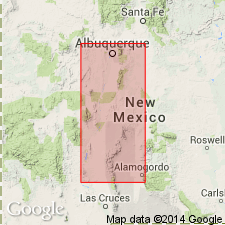
- Usage in publication:
-
- Hansonburg group
- Modifications:
-
- Named
- Dominant lithology:
-
- Limestone
- Clay
- Sandstone
- Shale
- AAPG geologic province:
-
- Orogrande basin
Summary:
Named as upper part of Missouri series for Hansonburg, the headwaters of the Bursam Ranch, about 5 mi east of north end of Oscura Mountains. Type locality is section measured in and near east portion of SE1/4 sec 31, T5S, R6E, northeast side of Oscura Mountains, Socorro Co, NM in Orogrande basin. Is divided into Burrego formation (new, at base) and Story formation (new, at top). Overlies Council Spring limestone of Veredas group (both new); underlies Del Cuerto formation of Keller group (both new) of Virgil series. Is 115 ft thick at type. Consists almost entirely of light-gray to purple, massive to nodular limestones with an interval of red shale, sandstone, and gray shale from 38 to 57.5 ft below top. However, in Mockingbird Gap (where it is 200 ft thick) and most other areas of central NM, group contains interbedded sandstones and gray shales. Contains fusulinid faunas that correspond closely with those of the Missouri series of Midcontinent terminology. Megafauna of group is large, but has not been studied in detail. Following genera identified: TRITICITES, DUNBARINELLA?, AND PSEUDOSTAFFEELLA?. Is of Pennsylvanian (Missouri) age.
Source: GNU records (USGS DDS-6; Denver GNULEX).
For more information, please contact Nancy Stamm, Geologic Names Committee Secretary.
Asterisk (*) indicates published by U.S. Geological Survey authors.
"No current usage" (†) implies that a name has been abandoned or has fallen into disuse. Former usage and, if known, replacement name given in parentheses ( ).
Slash (/) indicates name conflicts with nomenclatural guidelines (CSN, 1933; ACSN, 1961, 1970; NACSN, 1983, 2005, 2021). May be explained within brackets ([ ]).

